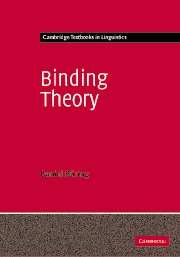Book contents
- Frontmatter
- Contents
- Preface
- 1 The ABC of Binding Theory
- 2 Interpreting indexed structures
- 3 Domains and orientation
- 4 Binding versus coreference
- 5 Other cases of semantic binding
- 6 The Coreference rule
- 7 Descriptive pronouns and individual concepts
- 8 Semantic binding and c-command
- 9 Plurals
- 10 Reciprocals
- 11 Exempt anaphora and reflexivity
- 12 Binding and movement
- Bibliography
- Index
Preface
Published online by Cambridge University Press: 05 June 2012
- Frontmatter
- Contents
- Preface
- 1 The ABC of Binding Theory
- 2 Interpreting indexed structures
- 3 Domains and orientation
- 4 Binding versus coreference
- 5 Other cases of semantic binding
- 6 The Coreference rule
- 7 Descriptive pronouns and individual concepts
- 8 Semantic binding and c-command
- 9 Plurals
- 10 Reciprocals
- 11 Exempt anaphora and reflexivity
- 12 Binding and movement
- Bibliography
- Index
Summary
This book presents a comprehensive treatment of the syntax and semantics of binding. It is meant to fill the gap between existing introductory texts, both semantic and syntactic, and the rich primary research literature on the topic. If you work your way through this book, you should be able to read and understand almost any of the works mentioned in the references.
There are at least two reasons why I thought such a book may be useful. First, Binding Theory figures prominently in a vast amount of works, either as the main research topic, or, perhaps even more frequently, as a diagnostic for constituency, derivational history, and other abstract aspects of grammatical analysis. I felt that an accessible survey of some of the more recent insights into the nature of binding would benefit both those who read those studies, as well as those who want to undertake them in the future.
Second, by its very nature, Binding Theory involves an equal amount of syntax and semantics. As such, it recommends itself as the topic for an advanced level textbook. There is, I believe, no insightful syntactic analysis without a solid semantics to access its adequacy; in any event, there certainly can't be any insightful analysis of the syntax of binding without a semantics to accompany it. The present book, therefore, is an introduction to doing syntactic and semantic analysis side by side.
Information
- Type
- Chapter
- Information
- Binding Theory , pp. ix - xiiPublisher: Cambridge University PressPrint publication year: 2005
